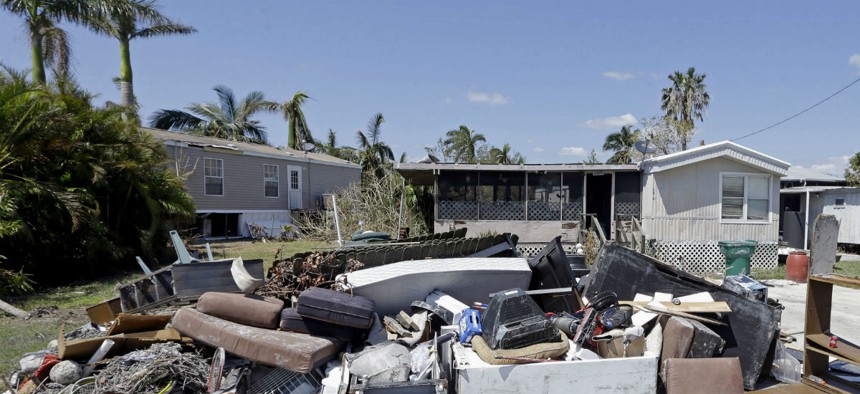
Debris from Hurricane Irma sits outside homes in Everglades City, Fla. Alan Diaz / AP
Thousands of Federal Employees Volunteer as Surge Force for FEMA Relief Efforts
Program had been limited to employees inside DHS but is now open governmentwide.
Thousands of federal employees are volunteering to join government relief efforts after successive hurricanes devastated the Gulf Coast and American Southeast.
As of Monday, almost 2,200 federal volunteers are on the ground as part of the Federal Emergency Management Agency’s Surge Capacity Force, with hundreds more volunteers ready to deploy immediately. As a supplement to FEMA responders, the surge force provides extra personnel when a disaster response requires more resources than FEMA has at its immediate disposal. Surge force volunteers are currently active in the areas hit by hurricanes Harvey and Irma, and will likely be sent to Puerto Rico and U.S. Virgin Islands as responses shift from the rescue to recovery phase.
The surge force is usually reserved only for Homeland Security Department employees, but with resources spread thin among hurricane relief efforts in Texas, Florida and the Caribbean, acting DHS Secretary Elaine Duke opened up the surge force program to all federal employees. This marked the first time all government employees became eligible for the program.
At press time, 239 non-DHS federal volunteers are on the ground helping with the recovery effort, and another 667 are registered and ready to deploy at a moment’s notice, DHS Assistant Press Secretary Justine Whelan told Government Executive. Volunteers are processed and trained at a DHS facility in Anniston, Ala., before heading off to the disaster areas.
Whelan said DHS had planned to eventually make the Surge Capacity Force available to employees at other agencies, but the recent storms hastened the process. The surge force will stay open to all government workers indefinitely.
While FEMA continues to lead many of the efforts on the ground in the disaster zones, the agency’s Chief Human Capital Officer Corey Coleman said this year’s particularly destructive hurricane season has begun pushing the limits of FEMA’s staff.
More than 5,300 of the almost 16,000 people who work at FEMA are currently deployed on the ground in hurricane efforts, according to a FEMA spokesperson. Though disaster relief is the agency’s primary function, employees are still responsible for the day-to-day operations that keep the agency up and running. After almost a full month of intense disaster response, Coleman said the FEMA workforce needs to regroup.
“Every employee has two different jobs: they have their job they do on a day-to-day basis, but they also have a disaster role,” Coleman said last Wednesday at a panel discussion hosted by Government Executive Media Group. “We’re supporting the disaster [relief], but we are getting to the point where we are looking for how to get the appropriate mix.”
Expanding the surge force program should relieve some of the pressure on FEMA. More than 6,500 DHS employees were registered as volunteers before Duke opened SCF to all federal employees. The agency is hoping to get at least 2,200 non-DHS volunteers to sign up. Coleman said as long as employees can get their agency’s approval, FEMA has a job for them.
“Unless we don’t need anymore people, I’ve never seen us turn anybody away,” he said.
Volunteers will have the chance to work in a variety of recovery responsibilities, including logistics; public assistance, such as debris monitoring; individual assistance, such as aid to survivors; disaster survivor assistance, to notify the public about available assistance programs; information technology; human resources; external affairs; acquisition; and planning. Their stint in the SCF will last a maximum of 45 days.
The government is calling not only on current employees to support relief efforts, but also asking federal retirees with relevant experience to join the response. The Small Business Administration announced it will hire a temporary workforce to help process the flood of hurricane-related disaster loan applications from Sept. 1 through the end of the year. SBA has hired over 1,300 people
The National Active and Retired Federal Employees Association encouraged members to answer SBA’s call for assistance. Federal retirees are especially equipped for these types of rapid response efforts given that many have previous experience in the area, NARFE Legislative Director Jessica Klement told Government Executive. Though every individual can contribute to relief efforts, federal retirees “may be the easiest to find, hire and train quickly,” she said. At least three NARFE members have come out of retirement to support disaster relief efforts, Klement said.
While Harvey and Irma responses have moved mostly to the recovery phase, FEMA is still leading search and rescue operations throughout Puerto Rico and the U.S. Virgin Islands in the wake of Maria. The category 4 storm slammed into Puerto Rico last Wednesday, knocking out power across the entire island. As of Monday morning, more than 90 percent of the island’s communications infrastructure remained out of operation, according to the Federal Communications Commission.







